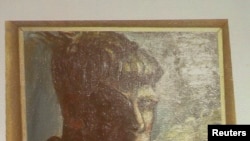WASHINGTON, D.C. —
A German media report says authorities confiscated a cache of about 1,500 works of art from an apartment in Munich in 2011. The works -- including paintings by Picasso, Matisse and Chagall -- have been missing for 70 years and are believed to have been private property confiscated by the Nazis from Jewish families.
The German magazine Focus reported on Sunday that Cornelius Gurlitt, the owner of the Munich apartment, inherited the missing art from his father. Hildebrand Gurlitt was a museum director hired by the Nazis to sell the works abroad, but kept some of them for himself.
A German government spokesman told reporters Monday that Bavarian state prosecutors are getting federal government in the form of experts on Nazi-looted art. The spokesman did not confirm or deny the magazine report.
"We [the German government] have been aware of the case for a couple of months already and that's why we are releasing the information that we're trying to provide help by arranging experts," said the spokesman.
Experts say that 20,000 works of modern art were confiscated from Jewish dealers in Nazi Germany; many remain missing. When they are discovered, they are claimed by the descendants of their former owners. Experts feel cases such as this bring light not only to the scale of how much the Nazis stole, but also to some disturbing trends that persist in the world of art.
"The Gurlitt case shows the extent of organized art theft in museum and private collections under the Nazis, when the works had all been the private property of Jewish owners. It also shows the lack of transparency in the art trade, because there was no research into provenance of the works that Gurlitt sold… Also, this discovery happened in 2011 and is only being publicized now," said Ruediger Mahlo, a representative of the Conference on Jewish Material Claims in Germany.
Focus magazine reported that the discovery came after a routine customs cash check on a train between Switzerland and Munich in 2010. Customs officials found the 80-year-old Gurlitt carrying the equivalent of about $12,000 in euros, apparently obtained from an art sale in a Swiss gallery.
The art found in Gurlitt's apartment is estimated to be worth more than $1 billion.
Mahlo said every piece must be investigated for provenance and recorded in the lost art database in Magdeburg.
The German magazine Focus reported on Sunday that Cornelius Gurlitt, the owner of the Munich apartment, inherited the missing art from his father. Hildebrand Gurlitt was a museum director hired by the Nazis to sell the works abroad, but kept some of them for himself.
A German government spokesman told reporters Monday that Bavarian state prosecutors are getting federal government in the form of experts on Nazi-looted art. The spokesman did not confirm or deny the magazine report.
"We [the German government] have been aware of the case for a couple of months already and that's why we are releasing the information that we're trying to provide help by arranging experts," said the spokesman.
Experts say that 20,000 works of modern art were confiscated from Jewish dealers in Nazi Germany; many remain missing. When they are discovered, they are claimed by the descendants of their former owners. Experts feel cases such as this bring light not only to the scale of how much the Nazis stole, but also to some disturbing trends that persist in the world of art.
"The Gurlitt case shows the extent of organized art theft in museum and private collections under the Nazis, when the works had all been the private property of Jewish owners. It also shows the lack of transparency in the art trade, because there was no research into provenance of the works that Gurlitt sold… Also, this discovery happened in 2011 and is only being publicized now," said Ruediger Mahlo, a representative of the Conference on Jewish Material Claims in Germany.
Focus magazine reported that the discovery came after a routine customs cash check on a train between Switzerland and Munich in 2010. Customs officials found the 80-year-old Gurlitt carrying the equivalent of about $12,000 in euros, apparently obtained from an art sale in a Swiss gallery.
The art found in Gurlitt's apartment is estimated to be worth more than $1 billion.
Mahlo said every piece must be investigated for provenance and recorded in the lost art database in Magdeburg.





